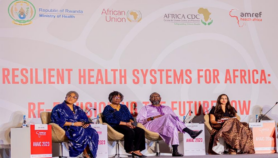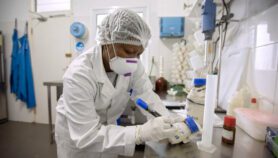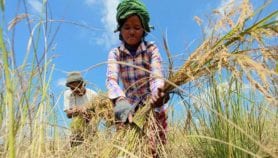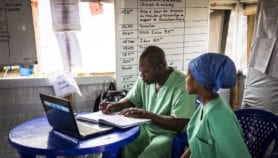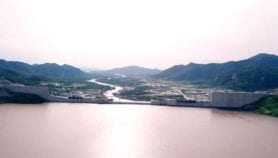By: T.V. Padma
Send to a friend
The details you provide on this page will not be used to send unsolicited email, and will not be sold to a 3rd party. See privacy policy.
Afghan farmers are weaning themselves off illegal poppy cultivation and branching out into other crops, reports T. V. Padma.
Crop scientist Aziz Osmanzai vividly remembers how farmland in Afghanistan became a battlefield in two decades of conflict that engulfed the mountain country.
More than half the agricultural land was lost. Many farmers fled for their lives, seeking refuge in neighbouring countries. All agricultural research infrastructure, tools and equipment were looted, he recalls.
Decades of conflict, bombings, fleeing refugees, and collapse of infrastructure have taken a heavy toll.
Unexploded land mines still lurk in hundreds of square kilometres of land that cannot be reclaimed for farming. Most irrigation canals and water storage systems lie in ruins, and in 1992 the national gene bank was destroyed.
In 2005 Afghanistan’s Ministry of Agriculture, Irrigation and Livestock drew up a master plan to revive the agricultural sector. But with ongoing security problems and the undeniable lure of the opium industry, its implementation — and success — faces many challenges.
The hard facts
Since 1978, the area of land under irrigation has declined by about 60 per cent, turning a country that was approaching self-sufficiency in crop production into an importer of food grains.
Afghanistan was famed in Asia for its nuts and grapes. It is the centre of origin of several crops such as carrot, plum, apricot, pistachio and almond. But much of its natural and genetic resource base now stands damaged.
In the early 1970s there were 22 agricultural research centres in Afghanistan. Most of them were abandoned, bombed, looted or confiscated by warlords.
The number of goats and sheep has halved over the past 30 years — from 30 million to 16 million — according to the UN Food and Agriculture Organization (FAO).
Agricultural production grew at less than one per cent each year from 1978–2001, compared to 2.2 per cent in 1961–78. The master plan aims for six per cent growth per annum by 2010, and a doubling of farm income by 2017. It estimates that US$1.6 billion is needed to achieve these aims, with an additional US$600 million for irrigation schemes.
But government departments are struggling to implement the measures. The plan notes that "most of the Afghan governmental institutions are dysfunctional and need serious reforms and capacity building before being able to operate efficiently".
A farmer and his children in a field split between poppies and potatoes
ICARDA/Dr Javed Rizvi
The rise of the poppy
With declining incomes, desperate farmers turned to illegal poppy cultivation for survival. Opium from poppy plants commands a far higher price than a cereal like wheat on the international markets. Gross income per hectare of poppy in 2007 was US$5,200, compared to US$546 for wheat. Little wonder that it made economic sense to embattled Afghan farmers.
Over 193,000 hectares in Afghanistan is now devoted to poppy farming, a figure that has doubled since 2005. The country supplies 93 per cent of the world’s illegal opium, according to a report by the International Narcotics Control Board released in March 2008.
In many rural areas, poppy cultivation supports the entire rural economy, and is linked to farmers’ access to land, credit and markets.
Last year an estimated 3.3 million people — or 14.3 per cent of the population — were engaged in poppy cultivation, according to government figures. The crop contributed 13 per cent of Afghanistan’s gross domestic product.
Minister of agriculture and irrigation Obaidullah Ramin says rooting out the poppy is the biggest challenge in the struggle to rebuild agriculture.
Afghanistan has allocated about US$385 million for 2008–09 to help poppy farmers establish themselves with different crops, and has banned poppy farming in 13 provinces.
Ramin, who attended a meeting of South Asian agriculture ministers, scientists and farmers’ cooperatives in Delhi in March 2008, hopes to impose a complete poppy ban in 2009. The government is also expanding its rural credit scheme to help farmers change livelihood.
Crop experts in Afghanistan estimate that horticulture — the growing of fruits, vegetables and flowers — is the only sector that offers competitive financial returns.
These once made up 40 per cent of Afghanistan’s exports. But today the sector is hindered by antiquated production methods, old or non-existent processing facilities, and a lack of commercial nurseries.
In 2007, Senlis Council, a UK-based security and development policy organisation, suggested legalising production of poppy for medicinal purposes, as the drug is used extensively as a painkiller. The council called for scientific pilot projects on ‘poppy for medicine’ as a solution to ensure income for farmers and to tackle the illicit drug menace (see Legalised opium production urged for Afghanistan).
But several Afghanistan-based experts are cautious about legalising poppy production, pointing out that the country still does not have effective monitoring and control mechanisms in place to ensure the crop is not being diverted for narcotics.
Seeds of change
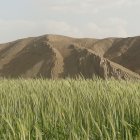


70,000 farmers were given improved wheat seeds in 2002
Flickr/sirslushy
Despite the difficulties, Ramin says Afghan agriculture is slowly reviving.
International organisations such as the FAO and the Syria-based International Centre for Agriculture in Dryland Areas (ICARDA) are focusing on improving access to hybrid seeds. They have released new varieties of wheat, rice, chickpea, lentils, barley, maize, and beans.
Other efforts include research to adapt crop varieties with economically useful traits to local conditions, training, and small-scale experiments on water efficiency and soil fertility.
In January 2002, ICARDA, with support from the United States Agency for International Development (USAID), brought together international crop experts to set up the Future Harvest Consortium to Rebuild Agriculture in Afghanistan (FHCRAA).
One of its first tasks was to supply improved wheat, an Afghan staple. FHCRAA provided seed to about 70,000 farmers in April 2002, just in time for spring planting.
"Availability of improved varieties and seeds remain major constraints and farmers are largely using low-yielding traditional varieties and crop production practices," Javed Rizvi, ICARDA’s country director in Afghanistan, told SciDev.Net.
ICARDA is addressing the problem by setting up village-based seed enterprises (VBSEs) as alternative seed delivery systems.
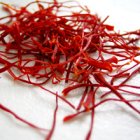


Saffron could be Afghanistan’s ‘red gold’
Flickr/zoyachubby
Cash crops
High-value crops such as saffron, mint and cucumber can be grown in winter using simple greenhouses and offer a way out of poppy farming.
The world’s most expensive spice, saffron (Crocus sativus) is known as Afghanistan’s red gold. ICARDA’s studies in Pashtun Zarghun in Herat province indicate that saffron gives higher returns than the poppy. Its cropping season does not clash with other crops, and it requires only two rounds of irrigation, which farmers in small land holdings with little access to water can manage.
However, farmers need initial government support to buy saffron bulbs. ICARDA is trying to persuade the government to provide farmers with incentives to increase cultivation.
An ICARDA project is linking with saffron research centres in Iran to train Afghan farmers in seeding methods, crop management, harvesting and drying techniques. Other training efforts target university and government staff.
A series of cooperatives of mint producers have sprung up in Helmand, Kabul, Kunduz and Nangarhar provinces. They provide farmers with cuttings of mint (Mentha) varieties and train them in crop management and processing, as well as distilling to produce mint water or mint oil for local and international markets for use in toothpastes and food industries.
Farmers are now harvesting 6–8 cuttings of mint per year, earning net profits of US$7,000–8,500 per hectare, say ICARDA scientists.
Supporting research
Farmers attending a training day
ICARDA/Dr Javed Rizvi
Ramin reminded the Delhi conference that it was the duty of South Asian countries and donor agencies to help Afghanistan rebuild its agricultural research system.
Afghanistan has, in particular, turned to India for help. On a visit in 2005, president Hamid Karzai appealed to India’s National Academy of Agricultural Sciences (NAAS) to help set up a similar academy in Afghanistan, to frame its agriculture policy and oversee implementation.
The NAAS team that visited in May 2007 identified five critical problems in the country’s agriculture: a shortage of trained scientific and technical manpower; inadequate research and teaching infrastructure; an absence of improved crop varieties, proven transferable technologies, farm machinery and power; poor post-harvest management and marketing facilities for agricultural products; and inadequate funds for research.
NAAS drew up an operational plan for an academy of agricultural sciences, three national crop research institutes and a university dedicated to agriculture. The plan is currently with the government.
"The restoration of research and extension system is the key to the recovery process of Afghan agriculture," a NAAS report notes. It estimates that an initial US$40 million is needed to restructure agricultural research.
Long road ahead
The task of reviving Afghanistan’s agriculture is mammoth.
As NAAS president and India’s top crop scientist M. S. Swaminathan notes, agricultural, and indeed any, development can forge ahead if lasting peace is restored in the country. Swaminathan told SciDev.Net that the country urgently needs help in three specific sectors: improved farm technologies to increase incomes, watershed management, and improved post-harvest technologies and market infrastructure.
There are some signs of progress. Six of the original 22 agriculture stations have been rebuilt by ICARDA, and are now engaged in crop improvement, technology transfer, business development and training for farmers. Nurseries are being planted to test yield, drought and cold tolerance and disease resistance.
The number of poppy-free provinces has doubled from six in 2006 to 13 in 2007. The area freed from the crop has risen from 15,300 hectares to 19,047 in the same period.
But these are small steps in the effort to restore Afghan agriculture to its former glory.




